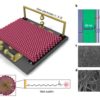A multifunctional molecule that plugs various atomic-scale defects in perovskite solar materials can significantly boost the longevity and electrical output of this promising solar technology, KAUST researchers have shown.
Perovskites are an alternative solar-cell material to silicon. They typically comprise a combination of negatively charged iodine or bromine ions and positively charged lead and organic ions. Adjusting the ion combination can generate wide bandgap perovskites that capture the solar wavelengths that silicon does not efficiently absorb. This suggests the two materials could be combined in tandem cells to capture even more energy from the Sun.
However, perovskites inevitably feature defects, such as where a particular ion did not slot into place during fabrication, leaving a gap in the structure. These reactive sites can contribute to rapid performance decline—unless they can be plugged. “Defect passivation is very important for improving the long-term stability of perovskite solar cells,” says Furkan Isikgor, a researcher in Stefaan De Wolf’s group.
Defect sites in perovskites can be positively or negatively charged depending on which ion is missing, but chemical additives for defect passivation can typically plug one type of defect or the other. But a molecule called phenformin hydrochloride (PhenHCl) overcomes this problem, Isikgor, De Wolf and their colleagues have shown.
“PhenHCl works very well owing to its multifunctional structure,” Isikgor says. The molecule consists of an electro-positive ammonium head group that can plug negatively charged defects and an electro-negative amine and imine group body to plug positive gaps.
The researchers showed that PhenHCl boosted the power conversion efficiencies (PCEs) of wide bandgap perovskites from 16.7 percent in untreated cells up to 20.5 percent in treated cells. “Moreover, PhenHCl passivation improves the PCE of textured perovskite/silicon tandem solar cells from 25.4 percent to 27.4 percent,” Isikgor says.
PhenHCl passivation also significantly improved the stability of the perovskite solar cell. “Under continuous light soaking, the PhenHCl-passivated device retained 80 percent of its post-burn-in efficiency for around 106 hours of operation,” Isikgor says. The untreated device retained 80 percent of its post-burn-in efficiency for only 5 hours.
“Our simple holistic defect-passivation strategy has drastically improved the semiconductor quality of solution-processed perovskites,” says De Wolf. “Passivating the different types of defects that may be present in perovskites with a single molecule is highly attractive for industry,” he adds. The next step will be to integrate PhenHCl passivation with scaled-up perovskite production. “Simultaneously, we are working on further improvements in device performance and stability through extensive outdoor testing,” De Wolf adds.
Fluoroethylamine engineering for effective passivation improves efficiency of perovskite solar cells
More information:
Furkan H. Isikgor et al, Concurrent cationic and anionic perovskite defect passivation enables 27.4% perovskite/silicon tandems with suppression of halide segregation, Joule (2021). DOI: 10.1016/j.joule.2021.05.013
Provided by
King Abdullah University of Science and Technology
Citation:
Plugging performance-sapping defects that hamper perovskite performance (2021, August 18)
retrieved 18 August 2021
from https://techxplore.com/news/2021-08-performance-sapping-defects-hamper-perovskite.html
This document is subject to copyright. Apart from any fair dealing for the purpose of private study or research, no
part may be reproduced without the written permission. The content is provided for information purposes only.



